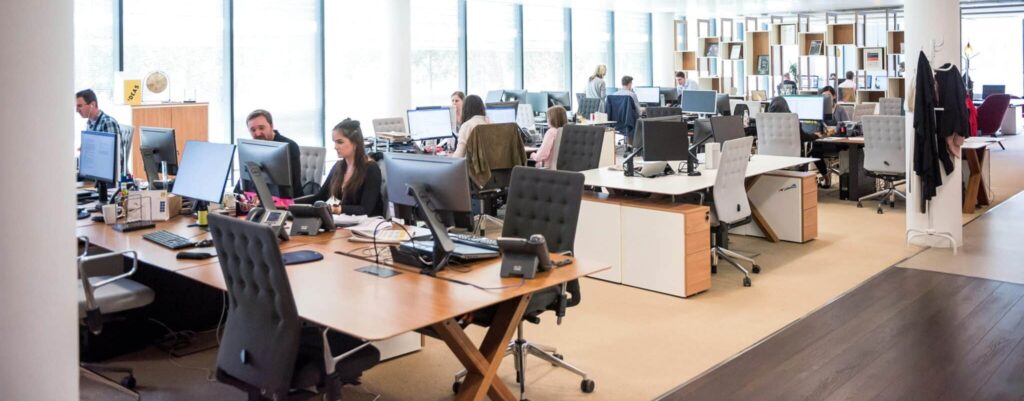Nurturing and Navigating the Workplace of Tomorrow

The Work Surgery Chief Experience Officer Martin Hale gives his insights into the future of work and what organizations need to do to attain long-term goals.
People have a natural obsession with predicting the future. Whether it’s betting on a sports game or trying to figure a test score, everyone wants to know the outcome before it happens.
In the realm of workplace, the road to the future is just as significant as the outcome. Martin Hale, Chief Experience Officer at The Work Surgery, helps organizations fulfill their long-term goals by equipping them with a clear outline of what they can do today to ensure their success tomorrow.
There’s obviously no one-size-fits-all methodology when it comes to future of work. That said, what are some of the most common things you see organizations struggle with in terms of strategy?
Hale: Culture is that thing we know is there, but we don’t fully understand the dynamics of. The job-for-life mentality has shifted to “what is the benefit to me in terms of pursuing the fulfillment of my potential?” There’s this whole reflection on what you are as an employee.
That’s where I see a struggle, in the inter-relationships between people. You get the problem of top-down or bottom-up approaches and neither is complete. One of the things I talk about with organizations are social contracts.
If you overcomplicate things — it never works. Create agreements at a team level or as an organization where it’s clearly defined that this is what the team or organization provides and these are your responsibilities. I think we often overlook individual responsibility at a team level to working effectively.

How do you better equip organizations with the necessary knowledge they need to predict challenges around the changing nature of work?
Hale: You have to have a sound knowledge of why the organization exists, who the clients are, and what they need today while adapting to the needs of tomorrow. If you’re recognizing that flexibility within the front office, how does that reflect in the back office? Your clients are maturing the same way your employees are. There’s this sort of duality going on.
I consider looking at that gap between the way individuals are nurtured in our education system and the experience of working in that environment to working in a more formalized work environment. It’s almost like free range talent versus someone who is battery farmed.

What types of businesses are leading in the future of work? What separates the leaders in this space from industries that may still be slightly behind?
Hale: The leaders in the future of work are those who really are authentic and have a sense of connecting their people with a shared outcome. One person that I often look to is Sir Richard Branson. He’s adapted his business successes over time as well as learning from those that have failed. I think one of the things that lies at the heart of what he does is believing in the investment of people to fulfill their potential and then treating them in a way that makes them want to stay.
If we look at the legal sector very closely, they’re still publishing great profit per equity partner (PEP) shares. On a two-dimensional level, that looks really impressive. The underlying impact on what’s changing and the way we work and the way clients have become more sophisticated moving from billable to fixed fees has an impact. There’s often a disconnect between what you get on an annual basis highlighting this success, but it doesn’t necessarily show you the underlying trend in that organization. One thing that today’s PEP doesn’t show is the need to recruit trainee lawyers with mathematical backgrounds who can work with the the advances in AI and machine learning.

What are some of the key metrics you use to determine if a future of work strategy is effective? Where do most organizations tend to struggle based on the data you’ve seen?
Hale: In a generalized sense, I think there’s a mindset where we achieve what we set out to do but then you take your foot off the accelerator and don’t continually challenge, or simply nudge, to ensure “bad” behaviours don’t come back.
What are the metrics we need and the KPIs we can create that actually measure the cost of people? We were recently looking at the cost of replacing a member of staff and it costs about 51,000 dollars to recruit another person. Do organizations really quantify or even understand those costs?
Property and people are the two largest costs on your P&L statement. We’ve kind of made sense of the property side, but we’re still unsure about that people cost whether it’s measured in number of non-billable hours or absenteeism to see if it’s effective. There’s also an engagement piece of how happy people are within their workplace.
Have we been blinded by the quest for measuring productivity? Perhaps if we can better understand the impact of the biggest organizational costs, which is the people, then we can have a clearer idea of quantifying the effectiveness of change.

Could you break down this concept you’ve coined as the “Consumerization of Work?” What does this term entail?
Hale: One of things I did when I started The Work Surgery was looking at what are trends from the past that can better help us navigate the future of work conversation. I wanted to see what the advent of corporate social responsibility (CSR) reporting could show us about shared values in the context of having a more authentic relationship with our work. In my mind, that was one of the first times companies were really thinking about their image at a quantifiable level that was actually appearing in annual reports and formalized.
I’m a fellow of the Royal Society of Arts in the U.K. and came across a paper in the archives about tomorrow’s company creating sustainable success. It was tying into the whole sustainability conversation around CSR. I started thinking that it’s actually kind of a parallel world to where we are today.
What does that tie into? What can we extrapolate from that? One of the recommendations was looking at that balance between collaboration and competition. It was about how to have an effective company of tomorrow with that free-flow of ideas that provide best outcomes and a consumerist commitment.
If you look at the trends around our relationships with brands, it gives us a dialogue and conversation to ask “when an individual engages with a company as a customer or employee, how authentic is that relationship?” Is that individual totally aware that everything they do ties in with the vision of the organization? Is what you’re doing today as a company adding to the fulfilment of that vision?

What do you think the workplace will look like in over next 10-15 years? How will it change?
Hale: I think organizations are going to be more porous. That could mean physical space in how far you allow non-full-time equivalent (FTE) employees to transcend into workspace. If you look at the growth of coworking spaces, people want to belong. We all have a sense of shared identity that’s aligned to aspirations. The coworking phenomenon is making those aspirations more tangible.
We’re still catching up to the transition from jobs-for-life to this sense of continuous learning. There are positives to that. One of the things we really have come to grasp is the illusion of security has actually made individuals more fearless. It’s not about the golden handshake at the end of your career where you get your pension for life.
Those long-term rewards are being replaced by the portfolio career and the gig economy where people are feeling more empowered to be in control of their own careers whether it’s tangible outcomes or long-term loyalty. It’s a trend that organizations will still be responding to in 10-15 years time because those generations will have come through.
The role of social media will also continue to grow. You look at Glassdoor as a great way of making organizations much more transparent about how they really are. We have a depth of information and maybe what we’ll end up doing is developing better filters. That will change how we perceive the role of work and place.
Find out more about how Martin and The Work Surgery can help your organization with its workplace strategy at their website.
How do you think future of work strategies are making organizations adapt? Join the conversation and leave us a comment below.
Photos: Rawpixel, Meric Dagli, Tom Swinnen, Rawpixel, Pierre Chatel-Innocenti




